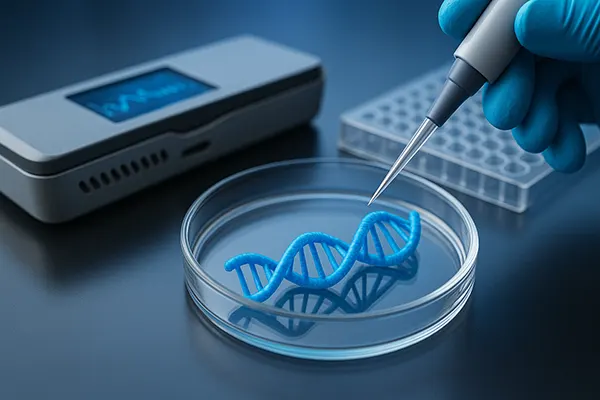
DNA-Based Biosensors for the Medicine of the Future
DNA-based biosensors are rapidly emerging as a crucial technology in the field of medical diagnostics. They combine the precision of molecular biology with advanced nanotechnology to detect genetic material and disease markers with exceptional accuracy. By 2025, their potential to transform preventive medicine and personalised healthcare has become a key focus in biomedical research worldwide.
Fundamental Principles and Design
DNA biosensors function by recognising specific nucleotide sequences through the process of hybridisation. When a complementary target binds to the sensor’s DNA probe, it produces a measurable signal. This signal can be optical, electrochemical, or piezoelectric, depending on the type of biosensor.
The use of nanomaterials such as gold nanoparticles, carbon nanotubes, and graphene has significantly improved their sensitivity and detection limits. These components enhance signal strength and enable the detection of even single molecules, making the technology suitable for early-stage disease diagnosis.
Modern biosensors are often integrated with microfluidic chips, allowing parallel analysis of multiple samples at once. This feature reduces diagnostic time and resource consumption while maintaining high reliability and reproducibility.
Detection Techniques and Performance
Electrochemical biosensors measure current or voltage changes triggered by hybridisation, offering low-cost and portable solutions. Optical biosensors use fluorescence or surface plasmon resonance to provide real-time data with high sensitivity.
Piezoelectric biosensors detect mass changes on the sensor surface caused by DNA binding, allowing label-free analysis. This method is particularly valued for its speed and ability to operate in complex biological samples without extensive preparation.
Combining these techniques with advanced data analytics has further enhanced accuracy, enabling clinicians to detect genetic mutations, infectious agents, and cancer biomarkers at very early stages.
Applications in Modern Healthcare
DNA-based biosensors are already being applied in infectious disease diagnostics, enabling the rapid identification of viruses such as SARS-CoV-2 and influenza. Their speed and specificity make them ideal for use during outbreaks or in resource-limited settings.
In oncology, these biosensors are used to detect tumour-specific genetic alterations, allowing doctors to personalise treatment plans. Early detection increases survival rates and reduces the side effects associated with aggressive therapies.
They are also applied in monitoring genetic disorders and prenatal screening, offering safer and less invasive alternatives to traditional diagnostic procedures. This contributes to improved patient care and more informed medical decisions.
Integration into Clinical Practice
To implement these technologies in hospitals, developers are working on miniaturised, user-friendly devices that can be used at the point of care. These devices eliminate the need for centralised laboratories, accelerating decision-making.
Healthcare professionals are receiving specialised training to operate biosensor-based diagnostic tools and interpret their results. This ensures the accuracy and consistency of clinical data.
Regulatory agencies are also developing frameworks to ensure biosensor safety, reliability, and ethical use, paving the way for their broader adoption in public health systems.

Future Perspectives and Ethical Challenges
As DNA biosensor technology advances, it is expected to integrate with wearable devices, enabling continuous health monitoring. This will allow real-time tracking of biomarkers and early detection of diseases before symptoms appear.
Artificial intelligence and machine learning are anticipated to play a major role in analysing biosensor data, identifying complex patterns, and predicting health outcomes. This will greatly expand their diagnostic potential.
However, the growing use of genetic data raises privacy and ethical concerns. Clear regulations, secure data storage, and informed consent processes are essential to maintain patient trust and protect sensitive information.
Global Impact and Research Outlook
Research into DNA biosensors is accelerating globally, supported by collaborations between universities, biotech firms, and healthcare institutions. This international effort is driving innovation and reducing development costs.
Funding from governmental and private sources is enabling large-scale clinical trials, which are crucial for validating biosensor technologies and gaining regulatory approval for clinical use.
If these trends continue, DNA-based biosensors could become standard diagnostic tools within the next decade, reshaping how diseases are detected, treated, and prevented worldwide.
